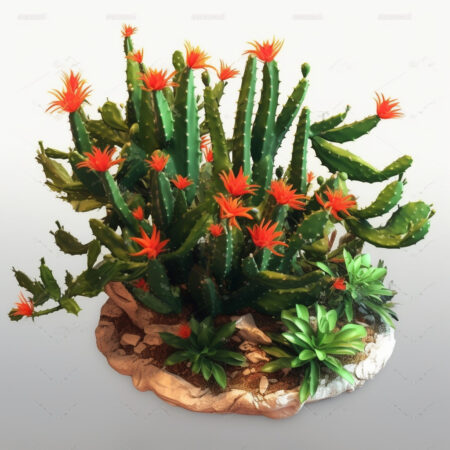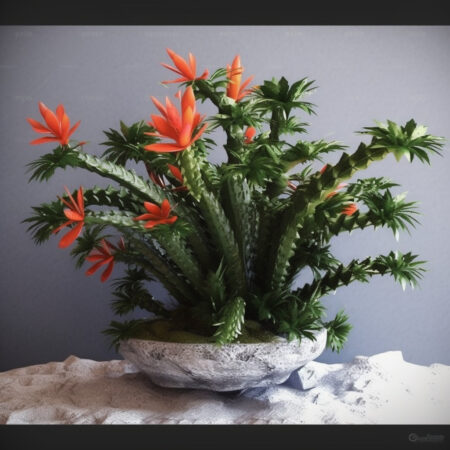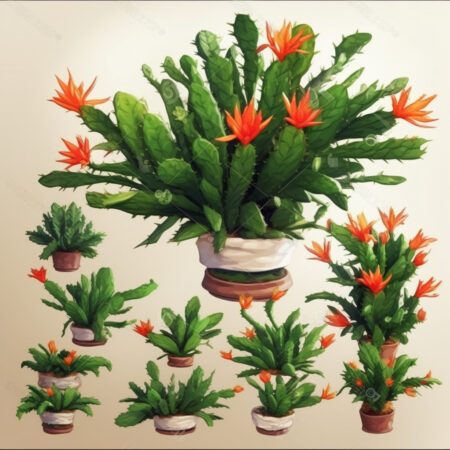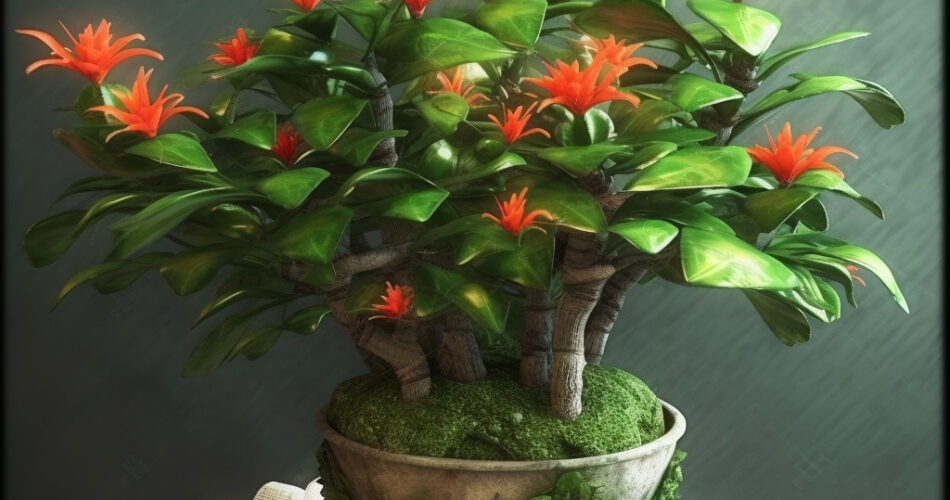Summary
- About Schlumbergera x Buckleyi: Schlumbergera x Buckleyi, also known as the Christmas Cactus, is a beautiful flowering plant that blooms during the holiday season. It is a hybrid of two cacti species and is well-loved for its vibrant colors and easy indoor cultivation.
- Growing and Care Tips: This tropical cactus thrives in bright, indirect light, well-draining soil, and moderate temperatures between 60-70°F. It is low-maintenance, non-toxic to pets, and has air-purifying qualities, making it a great choice for homes.
- Varieties and Decorative Ideas: Schlumbergera x Buckleyi comes in many vibrant varieties, such as ‘Christmas Flame’ and ‘Sunset Dancer.’ It can be paired with complementary plants like poinsettias for festive displays or given as a thoughtful holiday gift with easy care instructions.
Introduction to Schlumbergera X Buckleyi
Schlumbergera x buckleyi is a well-loved flowering plant that belongs to the Schlumbergera cactus family.
This type of plant comes from crossbreeding two other types of cacti: Schlumbergera truncata and Schlumbergera russelliana.
It is famous for its beautiful flowers that bloom during the holiday season, which makes it a favorite for festive decorations and gifts. The bright colors and unique blooming time make it perfect for adding a bit of nature to indoor spaces during the colder months.
Because of this, it has become a symbol of warmth, joy, and celebration, and is a popular choice for homes around the world.
What is Schlumbergera x buckleyi?
Schlumbergera x buckleyi is a tropical cactus that has flat, segmented stems with toothed edges. The stems are usually green, but some types of this plant may have colors like red or purple, which makes it look even more special.
The plant has beautiful, hanging flowers that can be pink, red, white, or orange, depending on the variety. The flowers have a unique tubular shape with layers of petals, making them look exotic and eye-catching. This plant is easy to grow indoors, which makes it a great choice for both experienced and beginner gardeners.
Origins and History
Schlumbergera x buckleyi was first discovered in the early 19th century in the coastal mountains of southeastern Brazil. This region has a humid, tropical climate, which is ideal for the growth of cacti like Schlumbergera.
The plant was named in honor of William Buckley, an English botanist who played a key role in introducing it to Europe. Buckley dedicated significant effort to cultivating and popularizing this species, which helped it become a favorite among plant enthusiasts.
Benefits of Growing
Growing Schlumbergera x buckleyi has many benefits for gardeners, whether they are experienced or just starting out:
- Blooms during the holiday season, adding color and festivity to indoor spaces. The bright flowers create a cheerful atmosphere, making it a great decoration for family gatherings and celebrations.
- Low-maintenance plant, perfect for busy people. Unlike many flowering plants, Schlumbergera x buckleyi doesn’t need a lot of special care, which makes it a great choice for those who don’t have a lot of time for gardening.
- Non-toxic to pets and children, which makes it safe for homes. This is especially important for families with pets or young kids who might touch the plant.
- Air-purifying qualities: Like many other houseplants, Schlumbergera x buckleyi helps improve indoor air quality by absorbing carbon dioxide and releasing oxygen, making the air healthier to breathe.
Cultivating Schlumbergera x buckleyi: Tips for Success
To grow Schlumbergera x buckleyi successfully, it’s important to give it the right care:
- Light: This plant likes bright, indirect light. Direct sunlight can burn the leaves, so it’s best to place it near a window with filtered light. A window facing east or north is usually ideal.
- Temperature: Prefers temperatures between 60°F and 70°F (15°C to 21°C). It doesn’t like extreme temperatures, so keeping the room temperature steady is key.
- Soil: Needs well-draining soil. A special mix made for cacti and succulents works best because it allows air to reach the roots and keeps water from building up.
- Watering: Water moderately, letting the top inch of soil dry out between waterings. Overwatering can cause the roots to rot, so it’s important to let the soil dry out a bit before watering again.
- Fertilization: Use a balanced fertilizer during the growing season (spring and summer). This helps the plant grow strong and produce bright flowers.
- Pruning: Prune the plant after it blooms to keep its shape and help it grow bushier. Pruning also helps remove any weak or dead stems, which keeps the plant healthy.
- Humidity: Schlumbergera x buckleyi likes moderate humidity. If your home is very dry, you can use a humidifier or mist the plant occasionally.

Schlumbergera x buckleyi vs. Other Holiday Cacti
Compared to other holiday cacti, Schlumbergera x buckleyi has some special features that make it stand out:
Distinguishing Features
- Segmented, flat stems with toothed edges. These unique segments give the plant an interesting look that makes it different from other types of cacti.
- Hanging flowers in shades of pink, red, white, and orange. The flowers hang down from the ends of the stems, making them look dramatic and beautiful.
Growth Habits and Care Requirements
- Moderate growth rate: Schlumbergera x buckleyi doesn’t grow very fast, but with the right care, it will produce new segments and flowers each year.
- Thrives in bright, indirect light. Unlike desert cacti that like direct sunlight, Schlumbergera x buckleyi prefers shaded, forest-like conditions.
- Needs well-draining soil and moderate watering. Using the right soil and watering properly is important to keep the plant healthy and avoid root rot.
Flower Characteristics and Blooming Season
- Blooms during the holiday season (late November to January), which is why it’s often called the Christmas Cactus. The flowers are not only beautiful but also last a long time, often staying bright for several weeks.
- Flowers last for several weeks, making the plant a great choice for adding long-lasting color to holiday decorations.
Environmental Adaptability and Hardiness
- Perfect for indoor growing. Schlumbergera x buckleyi does well indoors, making it a great addition to home decor.
- Thrives in average room temperatures. It doesn’t need special conditions, so it’s easy to grow in most homes.
- Not frost-tolerant: It’s important to keep this plant away from cold drafts and frost, as it cannot survive in freezing temperatures.
Growing Schlumbergera X Buckleyi Indoors
Choosing the Right Container and Soil
- Use a container with drainage holes to prevent root rot. Good drainage is very important to stop extra water from staying in the pot, which can harm the roots.
- Use a well-draining potting mix made for cacti and succulents. Adding perlite or sand can help the soil drain better, making sure the roots get enough air.
Temperature and Lighting Requirements
- Keep the temperature between 60°F and 70°F (15°C to 21°C). Don’t put the plant near drafts, air conditioning vents, or heaters, as sudden changes in temperature can stress it out.
- Place near a north or east-facing window for bright, indirect light. If the plant isn’t getting enough natural light, you can use a grow light to help it.
Watering and Fertilizing Tips
- Water when the top inch of soil feels dry, and water until it drains out of the bottom of the pot. This helps wash away any salts that may build up in the soil.
- Fertilize every 2-4 weeks during spring and summer with a balanced fertilizer made for cacti. Don’t overfertilize, as too much can cause salt buildup, which may harm the plant.
- Reduce watering in the fall to help encourage blooming. Letting the plant dry out a bit more than usual before the holiday season can help it produce more flowers.

Common Pests and Diseases of Schlumbergera x buckleyi
Identifying and Treating Pest Infestations
- Mealybugs: Look like white, cottony spots on the stems and leaves. These pests suck the sap from the plant, which can weaken it. Use a cotton swab dipped in rubbing alcohol to remove them, or use insecticidal soap.
- Spider mites: Cause webbing and yellow leaves. Spider mites are tiny and hard to see, but they can do a lot of damage. Increase humidity around the plant and use neem oil or insecticidal soap to get rid of them.
- Aphids: Small, green insects that gather on new growth and flower buds. Spray the plant with water to knock them off or use an organic insecticide.
Preventing Fungal and Bacterial Infections
- Make sure there is good air circulation and avoid overhead watering, as too much moisture can lead to fungal problems. Place the plant in a spot with good airflow, especially in winter when indoor humidity can be high.
- Use a proper fungicide or bactericide to treat infections. Signs of infection include rotting stems or discolored spots on the leaves. Cut off any affected parts to stop the spread of disease.
Dealing with Nutritional Deficiencies
- Yellow leaves or stunted growth might mean the plant is lacking nutrients like nitrogen, magnesium, or iron. Use a balanced fertilizer and adjust based on how the plant responds. You can also use a foliar spray to quickly fix deficiencies.
- Check the soil pH, as the wrong pH can keep the plant from getting enough nutrients. Schlumbergera x buckleyi does best in slightly acidic to neutral soil (pH around 6.0 to 7.0).
Creating a Stunning Display with Schlumbergera x buckleyi
Schlumbergera x buckleyi is a beautiful plant that can be used to create stunning indoor displays, especially during the holiday season. When planning how to showcase this plant, consider pairing it with complementary plants that will enhance its colors and shape.
Combining different plants can add texture, depth, and a festive atmosphere to your space, making it even more inviting. Below are some excellent companion plants that work well with Schlumbergera x buckleyi and ideas for showcasing them in creative ways.
Complementary Plants for a Vibrant Arrangement
- Poinsettias (Euphorbia pulcherrima): The bright red leaves of poinsettias look great next to the colorful flowers of Schlumbergera x buckleyi.
- English Ivy (Hedera helix): The trailing ivy adds texture and depth to the arrangement, making it look fuller and more interesting.
- Peace Lily (Spathiphyllum spp.): The white flowers of peace lilies go well with the bright colors of Schlumbergera, creating a beautiful and balanced display.
- Boston Fern (Nephrolepis exaltata): The feathery leaves of Boston ferns make a lush background that highlights the cactus’s colorful flowers.
Design Ideas for Showcasing
- Use it as a centerpiece on a dining table, surrounded by small holiday decorations like candles or pinecones for a festive feel.
- Hang it in a decorative macrame hanger near a window, so the flowers can hang down beautifully.
- Create a festive arrangement with holiday decorations. Add small ornaments or fairy lights to make it more cheerful.
- Terrarium-style display: Place Schlumbergera x buckleyi with other small succulents and decorative stones in a glass container for a unique, modern look.

Schlumbergera x buckleyi as a Gift
Creating Schlumbergera x buckleyi as a gift is a wonderful way to share its beauty and symbolism with loved ones. Below, you’ll find helpful tips for choosing the perfect plant and caring for it, ensuring that it thrives and continues to bring joy to its new home.
Choosing the Perfect Plant
- Choose a plant with healthy leaves and lots of buds. Avoid plants with yellow or droopy leaves, as this could mean they’re not healthy.
- Pick flower colors that match the recipient’s preferences. With so many color options, you can find one that suits their style.
Caring Tips for Gift Recipients
- Place the plant in bright, indirect light and keep it between 60°F and 70°F. Keep it away from drafts or direct sunlight, which can damage the leaves.
- Water when the top inch of soil is dry and fertilize during the growing season. This will help the plant stay healthy and bloom for years.
- Include a care guide: Add a small note with basic care tips to help the recipient take care of their new plant.
Exploring Schlumbergera x buckleyi Varieties
Exploring the different varieties of Schlumbergera x Buckleyi can help you choose the perfect one for your home or as a gift. Each cultivar offers unique colors and features that make them special additions to any indoor space.
- ‘Christmas Flame’: Has bright red flowers that are great for holiday decorations. The bold color adds a festive feel to any room.
- ‘Easter Lily’: Has pure white flowers that give a feeling of peace and simplicity. This variety is often used in more minimalistic arrangements.
- ‘Golden Charm’: Produces golden-yellow flowers that brighten up any space. The warm color is perfect for adding a bit of cheer.
- ‘Pink Pearl’: Features soft pink flowers that add a gentle touch of color. This variety is popular for its delicate and elegant appearance.
- ‘Sunset Dancer’: Displays orange and pink bi-colored flowers that resemble a beautiful sunset. It is perfect for adding a vibrant and unique look to any space.
- ‘Ruby Star’: Produces deep red flowers with a star-like shape. The rich color makes this variety stand out, adding a dramatic flair to holiday decorations.
Rare and Unique Varieties
In addition to popular cultivars, there are several rare and unique varieties of Schlumbergera x Buckleyi that are highly sought after by plant enthusiasts. These varieties stand out for their special characteristics and striking appearances.Rare and Unique Varieties**
- ‘Fantasia’: Has variegated leaves with shades of green and cream, along with pink flowers. The mix of colorful leaves and bright flowers makes this variety very special and visually striking.
- ‘Moonlight Magic’: Has pale yellow flowers that are soft and elegant. This variety is perfect for those who like a more subtle and calming look. Its unique, gentle color sets it apart from more common vibrant varieties.
- ‘Dragon Fruit’: Produces bright magenta flowers that really stand out. This variety is rare and highly sought after because of its vivid and striking appearance, making it a favorite among collectors.
- ‘Candy Cane’: Features striped flowers in red and white, resembling a candy cane. This unique pattern makes it a popular choice for the holiday season, adding a playful and festive touch.
- ‘Twilight Glow’: Exhibits peach or apricot-colored flowers that glow warmly, especially in indirect light. The warm tones of this variety make it stand out and add a cozy atmosphere to any room.
- ‘Mystic Flame’: Has deep orange flowers with hints of red, giving it a fiery appearance. This variety is unique for its bold color combination, which makes it a striking focal point in any arrangement.
Troubleshooting Common Issues with Schlumbergera x buckleyi
Yellowing or Dropping Leaves
- Overwatering or underwatering can cause yellow leaves. To avoid this, always check the soil moisture before watering. Stick your finger about an inch into the soil—if it feels dry, it’s time to water. Using a moisture meter can also help ensure you’re providing the right amount of water. Learn more about proper watering techniques here.
- Temperature stress and lack of nutrients can also cause yellowing leaves. Make sure the plant is in a stable environment, ideally between 60°F and 70°F (15°C to 21°C), away from drafts or heat sources. Providing a balanced fertilizer every 2-4 weeks during the growing season can help prevent nutrient deficiencies. Check this guide for tips on keeping indoor plants healthy.
- Poor drainage can also lead to yellow leaves due to root rot. Make sure the pot has enough drainage holes to let extra water escape. Use a well-draining potting mix specifically for cacti and succulents. Adding perlite to the mix can improve drainage. Read more about improving soil drainage here.
Lack of Blooming
- Make sure the plant gets enough light and cooler temperatures before the blooming season. The plant needs cooler temperatures (around 50°F to 55°F or 10°C to 13°C) for about 6-8 weeks to encourage it to bloom. During this time, try placing the plant in a cooler room or near a slightly open window where it can experience the temperature drop it needs. Using a grow light can also help provide consistent lighting if natural light is limited. Learn more about optimizing light conditions for blooming here.
- Don’t overfertilize or prune too much, as this can stop the plant from flowering. Use a diluted fertilizer once a month during the growing season, but stop feeding the plant about a month before the blooming period. Excessive pruning can remove potential flower buds, so only prune to maintain shape after the blooming season. Check out this guide on proper fertilizing techniques for holiday cacti.
Overwatering and Root Rot
- Use well-draining soil and water only when needed. Let the soil dry out between waterings to avoid root rot. Using a cactus or succulent-specific soil mix is ideal, as it allows for better aeration and drainage. Adding perlite or coarse sand can also help improve drainage. Learn more about choosing the right soil mix here.
- Trim off any affected roots and repot in fresh soil if you notice root rot. If the plant has signs of root rot, such as soft, mushy, or darkened roots, remove it from its pot, cut away the damaged roots, and repot it in dry, well-draining soil. Make sure to use a clean pot to avoid any lingering pathogens. After repotting, wait a few days before watering to give the plant time to adjust and prevent further root issues. Learn more about dealing with root rot here.
Leaf Spots and Diseases
- Remove any affected leaves and use the right fungicides or bactericides to treat the plant. Leaf spots can be caused by fungal or bacterial infections, often from too much humidity or water sitting on the leaves. It is important to reduce humidity around the plant and avoid water buildup on the leaves to prevent these infections. Learn more about treating plant leaf spots effectively.
- Avoid overhead watering and make sure there’s good airflow to prevent diseases. Keeping enough space between plants also helps stop the spread of diseases. Consider using a small fan to increase air circulation if needed. Read about preventing common plant diseases.
- Quarantine new plants before adding them to your collection to prevent pests or diseases from spreading. Isolate new plants for at least two weeks and inspect them regularly for any signs of pests or disease before moving them near your other plants. Check this guide on how to quarantine new houseplants.
By following these simple tips, you can enjoy the beautiful and festive blooms of Schlumbergera x buckleyi for many seasons to come. With proper care and attention, this lovely holiday cactus will reward you with bright, long-lasting flowers that will light up your home during the winter months.
Conclusion
Schlumbergera x Buckleyi is more than just a beautiful plant; it is a symbol of warmth, joy, and festive spirit that brightens up any home during the holiday season. With its diverse varieties, stunning blooms, and relatively low-maintenance care requirements, this plant has become a popular choice for both experienced and beginner gardeners.
Whether you want to grow it for its vibrant holiday flowers, give it as a meaningful gift, or create a stunning indoor display, Schlumbergera x Buckleyi offers endless possibilities. By following the care tips and troubleshooting advice provided in this guide, you can ensure that your Schlumbergera x Buckleyi thrives and brings joy to your space for many seasons to come.




Comments